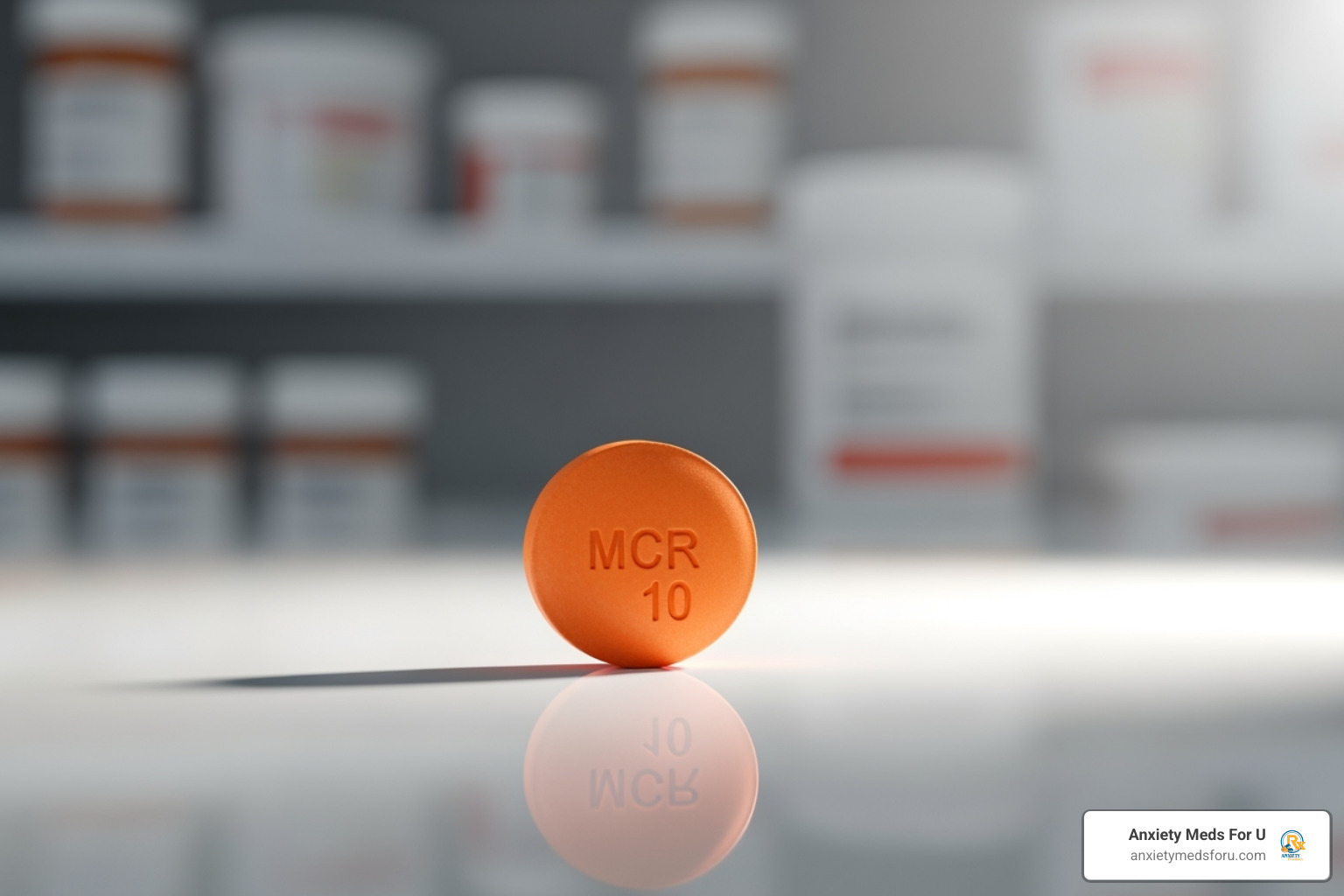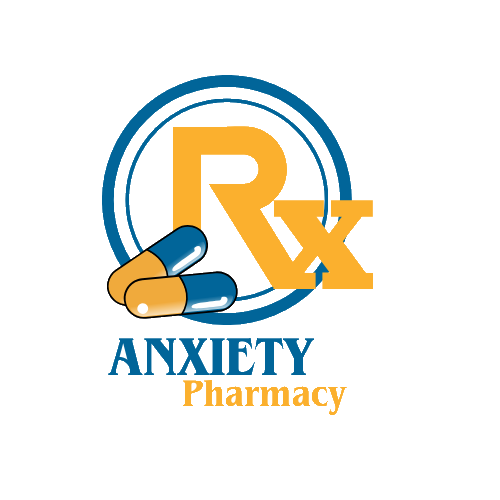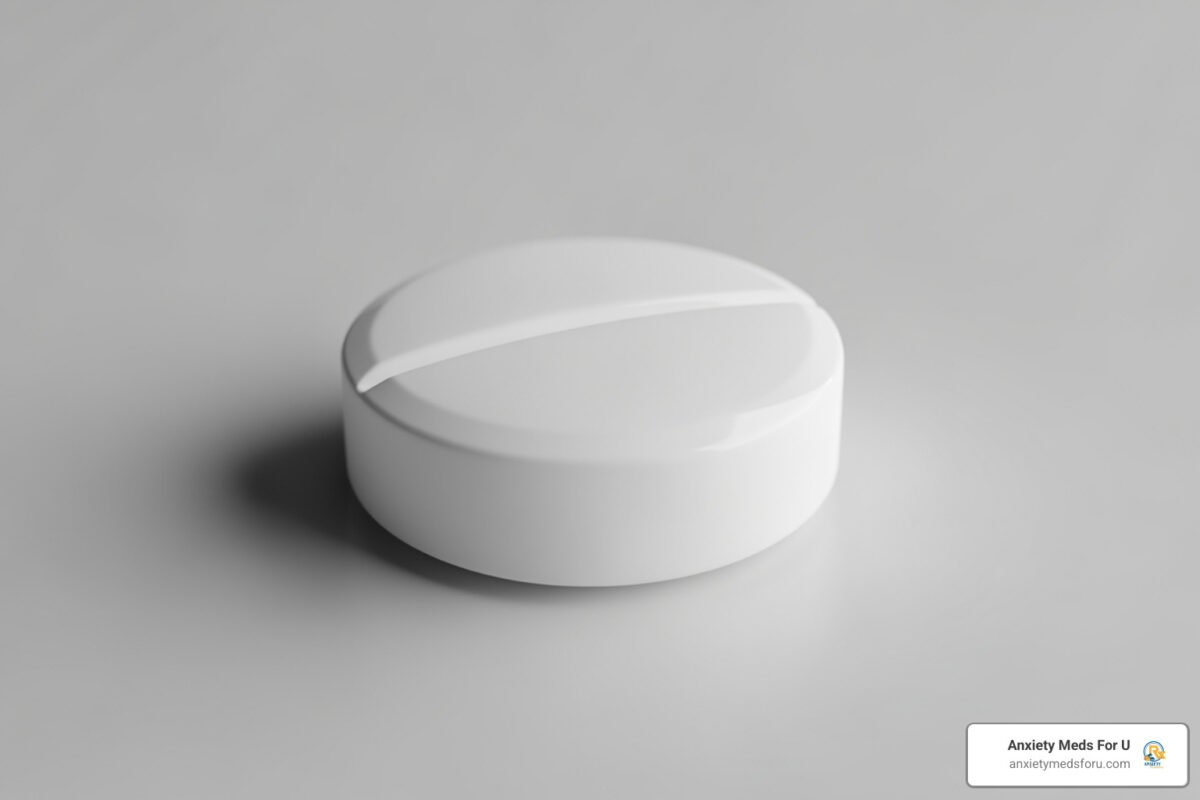A – Z Guide to Cyclobenzaprine 10mg

Understanding Cyclobenzaprine 10mg: The Complete Muscle Relaxant Guide
Cyclobenzaprine 10mg is a prescription muscle relaxant used to treat acute muscle spasms and pain from injuries or strains. This medication works in your brain and nervous system to block nerve signals that cause muscle spasms, providing relief when used alongside rest and physical therapy.
Key Facts About Cyclobenzaprine 10mg:
- What it treats: Acute muscle spasms, pain, and stiffness from muscle injuries
- How it works: Blocks nerve impulses in the brain stem that cause muscle spasms
- Typical dosage: 10mg taken three times daily (maximum 60mg per day)
- Duration: Short-term use only (2-3 weeks maximum)
- Onset: Effects begin within 1 hour
- Common side effects: Drowsiness (up to 39%), dry mouth (up to 32%), dizziness
- Not for: Long-term use, spasticity from brain/spinal cord diseases, children under 15
Cyclobenzaprine belongs to a class of medications called skeletal muscle relaxants. Unlike painkillers, it doesn’t directly target pain receptors. Instead, it acts on your central nervous system at the brain stem level, reducing the excessive muscle activity that causes spasms and discomfort.
The 10mg strength is the most commonly prescribed dose for adults, though some patients may start with 5mg and work up based on their response and tolerance to side effects.
I’m John, and I’ve spent years helping people understand prescription medications and find affordable access to the treatments they need. Through my work with online pharmacy services, I’ve seen how cyclobenzaprine 10mg can provide significant relief for those dealing with acute muscle pain when traditional remedies aren’t enough. Let me walk you through everything you need to know about this effective muscle relaxant.

Before we dive deeper, if you’re looking for comprehensive solutions for pain management, we offer a wide range of pain relief options custom to your needs. You can explore them here: More info about our pain relief options.
What is Cyclobenzaprine Used For?
Cyclobenzaprine, particularly the cyclobenzaprine 10mg dosage, is primarily used as an adjunct to rest and physical therapy to provide relief from muscle spasms associated with acute, painful musculoskeletal conditions. Think of it as a helpful partner in your recovery journey, not a solo act.
When we talk about “acute, painful musculoskeletal conditions,” we’re referring to short-term issues like:
- Acute muscle spasms: Sudden, involuntary muscle contractions that can be incredibly uncomfortable.
- Pain relief: It helps alleviate the pain that comes with these spasms.
- Stiffness reduction: By relaxing the muscles, it helps reduce stiffness and improve mobility.
- Muscle injury: Common injuries like strains from overexertion or accidents.
- Strains: Tears or stretches in muscles or tendons.
It’s crucial to understand what cyclobenzaprine is not used for. It is not effective for treating spasticity related to central nervous system (CNS) diseases, such as cerebral palsy. In these conditions, muscle stiffness and spasms stem from different neurological pathways, and cyclobenzaprine’s mechanism of action is not suited to address them. Our goal is always to ensure you receive the right medication for the right condition, and cyclobenzaprine shines brightest for acute, local muscle issues.
How Does It Relieve Muscle Spasms?
Now, for the really fascinating part: how does this little pill calm those angry muscles? Cyclobenzaprine 10mg works its magic by acting primarily within the central nervous system, specifically at the brain stem levels. It’s like a gentle conductor directing an unruly orchestra of nerve signals.
Here’s the simplified science:
- Acts on the brain stem: Unlike some medications that directly affect the muscles, cyclobenzaprine operates higher up the chain, influencing nerve impulses in your brain stem.
- Reduces tonic somatic motor activity: This means it decreases the continuous, low-level nerve activity that keeps muscles in a state of tension or spasm. It essentially tells those overactive nerves to take a chill pill (pun intended!).
- Does not directly relax skeletal muscle: This is a key distinction. It doesn’t work directly on the muscle fibers themselves. Instead, it blocks the nerve impulses (or pain sensations) that are sent to your brain, which then helps the muscles relax indirectly. It’s more about calming the “command center” that’s sending out spasm signals.
The good news is that you don’t have to wait ages for relief. The onset of action for cyclobenzaprine is relatively quick; its effects can typically be felt within one hour of taking the medication. This rapid action means you can get to feeling better faster, allowing you to focus on rest and physical therapy. For more in-depth information on how it helps, you can check out this resource: Works well to relieve muscle spasms.
Understanding the Proper Dosage and Use of Cyclobenzaprine 10mg

Getting your cyclobenzaprine 10mg dosage right isn’t just important—it’s absolutely essential for both your safety and getting the relief you need. Think of it like following a recipe: you wouldn’t add extra salt and expect the dish to taste better, right? The same principle applies here.
Your doctor has carefully calculated your prescription based on your specific condition, medical history, and how your body might respond to the medication. This isn’t a guessing game or a “try more if it doesn’t work” situation. Following your prescription exactly is the golden rule that keeps you safe while maximizing your chances of feeling better.
Here’s something that might surprise you: cyclobenzaprine is designed for short-term use only, typically lasting just 2-3 weeks. Why so brief? Well, acute muscle spasms are usually temporary visitors, not permanent residents. Your body is remarkably good at healing itself when given the right support, and extending treatment beyond this timeframe rarely provides additional benefits. Plus, longer use can invite unwanted side effects to the party.
When taking your medication, these tablets are meant to be swallowed whole with a full glass of water. Don’t get creative by crushing, chewing, or breaking them unless your healthcare provider specifically tells you otherwise. The good news? You can take cyclobenzaprine 10mg either with or without food. If you notice some stomach upset, try taking it with a light meal or a glass of milk—your stomach will thank you.
One final but crucial point: never share your medication with friends, family, or anyone else, even if they’re experiencing similar symptoms. What works safely for you might be dangerous for someone else due to different health conditions, other medications, or individual sensitivities.
Recommended Dosages and Administration
Let’s talk numbers, because when it comes to cyclobenzaprine 10mg, precision matters. For adults between 15-64 years old, the typical starting approach involves taking the medication three times daily. Your doctor might start you on a lower dose and gradually work up to find your sweet spot—this process is called titration, and it’s like fine-tuning a radio to get the clearest signal.
The typical dose is 10mg three times a day, which means you’ll be taking one tablet in the morning, one in the afternoon, and one in the evening. This spacing helps maintain consistent levels of the medication in your system throughout the day, providing steady relief from those troublesome muscle spasms.
Here’s an important safety boundary: the maximum daily dose should never exceed 60mg. That’s six 10mg tablets in a 24-hour period, and honestly, most people find relief with less than this maximum amount. Your doctor will help determine the lowest effective dose for your situation—because why take more than you need?
The timing of your doses matters too. Try to space them evenly throughout the day, and if possible, take them at the same times each day. This consistency helps your body maintain steady medication levels and can improve how well the treatment works. For detailed technical information about immediate-release tablets, you can reference official medical databases.
What Happens if You Miss a Dose of Cyclobenzaprine 10mg?
Life gets busy, and sometimes we forget things—it happens to the best of us! If you realize you’ve missed a dose of cyclobenzaprine 10mg, don’t panic. The key is handling it safely and getting back on track without causing yourself any harm.
If you remember your missed dose relatively soon after it was supposed to be taken, go ahead and take it as soon as you remember. However, if you’re getting close to your next scheduled dose—say, within a few hours—it’s better to skip the missed dose entirely. Think of it like missing a train: sometimes it’s better to wait for the next one rather than running dangerously to catch the one that’s already leaving the station.
The most important rule here is simple: never, ever double up on doses. Taking two doses at once won’t make up for the missed one, and it significantly increases your risk of experiencing side effects. Instead, just maintain your regular schedule from your next planned dose forward.
If you find yourself frequently forgetting doses, consider setting phone alarms or using a pill organizer. Consistency helps the medication work its best, but your safety always comes first.
Overdose and Emergency Procedures
While we never want to scare anyone, it’s crucial to understand that overdose can be fatal with cyclobenzaprine. This isn’t meant to frighten you—when used as prescribed, the medication is generally very safe—but awareness can save lives.
An overdose might show up as severe drowsiness that goes far beyond normal tiredness, a fast or irregular heartbeat that feels concerning, seizures, confusion, or even coma. Other warning signs include extreme agitation, slurred speech, hallucinations, or very low blood pressure.
If you suspect an overdose—whether it’s you or someone else—seek immediate medical attention by calling 911. You can also contact the Poison Help line at 1-800-222-1222 for guidance. Medical professionals may need to perform gastric decontamination procedures to help remove the medication from the system.
Time is critical in overdose situations, so don’t hesitate or try to “wait it out.” When in doubt, always err on the side of caution and get professional help immediately.
How to Store Cyclobenzaprine

Proper storage might seem like a small detail, but it’s actually crucial for keeping your cyclobenzaprine 10mg effective and safe throughout its entire shelf life. Think of your medication as needing its own comfortable environment to stay in peak condition.
The ideal storage spot maintains a room temperature between 68-77°F (20-25°C). This rules out places like your car’s glove compartment (too hot in summer, too cold in winter) or that sunny windowsill in your kitchen. Your medication prefers stability, just like most of us do.
Keep your tablets away from moisture, heat, and direct light. This means the bathroom medicine cabinet—despite its name—is actually one of the worst places to store medication. All those steamy showers create humidity that can break down your medication over time. Instead, choose a cool, dry cupboard away from the kitchen stove and bathroom steam.
Always keep the medication in its original, tightly sealed container. The manufacturer designed that bottle specifically to protect the tablets from air and humidity. Plus, you’ll have all the important information right there on the label when you need it.
Most importantly, keep all medications out of reach of children. This isn’t just good advice—it’s a safety imperative. Medications that cause drowsiness can be particularly dangerous for curious little ones, so store everything securely and out of sight.
Potential Side Effects and Drug Interactions
Let’s be honest – no medication is perfect, and cyclobenzaprine 10mg comes with its share of potential side effects. The good news? Most people tolerate it well, and the benefits often outweigh the risks when used properly. Think of side effects like houseguests – some are mild and barely noticeable, while others demand immediate attention.
My approach has always been to arm you with knowledge so you can spot any issues early and know exactly when to pick up the phone and call your doctor. After all, being informed is your best defense against unwanted surprises.
If you’re exploring different pain management options, we have an extensive selection that might better suit your needs. Feel free to browse our complete range: More info about our other pain relief medication.
| Side Effect Type | Examples | What to Do |
|---|---|---|
| Common (Usually Manageable) | Drowsiness (39%), Dry mouth (32%), Dizziness, Fatigue | Monitor and report if bothersome |
| Serious (Seek Help Immediately) | Serotonin Syndrome, Irregular heartbeat, Seizures, Chest pain | Stop medication, call doctor or 911 |
Common and Serious Side Effects of Cyclobenzaprine 10mg
When you start taking cyclobenzaprine 10mg, your body needs time to adjust. Most side effects fall into the “annoying but not dangerous” category, and they often improve as your system gets used to the medication.
The most common side effect is drowsiness, affecting up to 39% of people taking the medication. It’s like your brain decides to hit the dimmer switch without asking permission first! This is why I always tell patients to test the waters before driving or operating any machinery. You might feel perfectly fine, or you might feel like you’ve been hit by the sleepy truck.
Dry mouth comes in second, bothering about 32% of users. Your mouth might feel like you’ve been chewing cotton balls, but there are simple fixes. Sipping water throughout the day, chewing sugar-free gum, or even sucking on ice chips can provide relief. Some people find that keeping a water bottle nearby becomes second nature.
Dizziness and fatigue round out the common complaints. You might feel a bit unsteady when standing up quickly, or experience that general “blah” feeling that makes you want to curl up on the couch. These effects usually fade as your body adapts to the medication.
Now, let’s talk about the side effects that demand immediate attention. While rare, serotonin syndrome is the big scary one we watch for. Your body essentially gets flooded with too much of the “feel-good” chemical serotonin. Early signs include restlessness, rapid heartbeat, sweating, and muscle twitching. In severe cases, you might experience high fever, confusion, severe muscle rigidity, or even seizures. If any of these symptoms appear, stop taking the medication immediately and seek emergency care.
Heart rhythm problems are another serious concern. If you notice your heart racing, skipping beats, or fluttering like a butterfly in your chest, don’t wait it out. Any new chest pain, difficulty breathing, or feelings of faintness warrant immediate medical attention.
Seizures and hallucinations are rare but serious red flags. If you start seeing or hearing things that aren’t there, or if you experience any seizure activity, this is your cue to call for help right away.
You can help keep everyone safer by reporting any adverse reactions you experience. The FDA maintains a system for tracking these reports: Report Adverse Events to the FDA. Your experience matters and could help protect other patients.
Key Drug and Substance Interactions
Here’s where things get a bit more complicated. Cyclobenzaprine 10mg is quite the social butterfly when it comes to interacting with other substances, but unfortunately, not all of these interactions are friendly. Some can amplify side effects, while others can create genuinely dangerous situations.
Alcohol is the biggest troublemaker on this list. Both alcohol and cyclobenzaprine slow down your central nervous system, so combining them is like pressing the slow-motion button twice. The result? Extreme drowsiness, impaired coordination, and seriously compromised judgment. Even a single drink can pack a much bigger punch than usual.
MAO inhibitors represent an absolute no-go zone. These medications (including isocarboxazid, phenelzine, selegiline, and others) cannot be taken with cyclobenzaprine under any circumstances. If you’ve taken an MAO inhibitor within the past 14 days, you’ll need to wait before starting cyclobenzaprine. The combination can trigger serotonin syndrome, which we definitely want to avoid.
Other medications that cause drowsiness create a compounding effect. This includes barbiturates like phenobarbital, benzodiazepines such as Xanax or Valium, sleeping pills, narcotic pain medications, and even some antihistamines like Benadryl. Think of it as adding sleepy pill on top of sleepy pill – the math doesn’t work in your favor.
Antidepressants require special attention because of their serotonin effects. SSRIs like Prozac or Zoloft and SNRIs like Cymbalta can increase your risk of serotonin syndrome when combined with cyclobenzaprine. The same goes for tramadol, a pain reliever that also affects serotonin levels.
Bupropion, while an antidepressant, works differently but still deserves caution when combined with muscle relaxants. Your doctor will need to carefully balance the benefits and risks if you need both medications.
The key takeaway? Never start, stop, or change any medication without talking to your healthcare provider first. This includes over-the-counter drugs, herbal supplements, and yes, even that innocent-looking melatonin you take for sleep. Your pharmacist and doctor need the complete picture to keep you safe and ensure your medications work as intended.
Important Precautions and Special Populations
Before starting cyclobenzaprine 10mg, having a heart-to-heart with your doctor isn’t just recommended—it’s essential. Think of your healthcare provider as your personal safety consultant who needs the full picture to keep you safe and healthy.
We can’t emphasize this enough: be completely transparent about your medical history. Share everything—existing health conditions, allergies, medications you’re taking (including over-the-counter drugs and supplements), and even recreational substances you might use. This comprehensive disclosure helps your doctor determine if cyclobenzaprine is right for you and spot any red flags before they become problems.
One of the biggest precautions with cyclobenzaprine 10mg involves its impact on your daily activities. Since this medication can make you drowsy and dizzy, you’ll need to be extra cautious about activities that require sharp mental focus and quick reflexes. Driving or operating machinery should be off-limits until you know exactly how the medication affects you. We’ve all heard the phrase “better safe than sorry,” and it couldn’t be more relevant here.
If you’ve been taking cyclobenzaprine for an extended period, don’t just stop cold turkey. Avoid abrupt cessation after long-term use without talking to your healthcare provider first. While cyclobenzaprine isn’t considered addictive, suddenly stopping can sometimes trigger withdrawal-like symptoms such as nausea, headaches, and general discomfort. Your doctor can help you safely taper off if needed.
Warnings for People with Certain Health Conditions
Some health conditions and cyclobenzaprine 10mg simply don’t mix well. If you have any of these conditions, your doctor will need to proceed with extra caution or may recommend avoiding cyclobenzaprine altogether.
Heart conditions top the list of concerns. If you have any heart problems, this medication might not be for you. Specifically, cyclobenzaprine is absolutely contraindicated if you’re recovering from a recent heart attack, have irregular heartbeats (arrhythmias), heart block, other electrical conduction problems in your heart, or congestive heart failure. The medication can potentially worsen these conditions or interfere with your heart’s electrical system.
Liver disease presents another significant concern. Your liver is responsible for processing cyclobenzaprine, so if it’s not functioning optimally, the medication can build up in your system. This accumulation increases your risk of side effects and can potentially cause problems. Your doctor may need to adjust your dose downward or monitor your liver function more closely.
Glaucoma patients need to be particularly careful. Cyclobenzaprine has anticholinergic effects, which is a fancy way of saying it can increase pressure inside your eyes and potentially worsen narrow-angle glaucoma.
Similarly, if you have urinary retention problems or an enlarged prostate, cyclobenzaprine’s anticholinergic properties can make it even harder to empty your bladder completely. This can lead to uncomfortable and potentially serious complications.
Finally, hyperthyroidism (an overactive thyroid gland) is another absolute contraindication. The combination of an overactive thyroid and cyclobenzaprine can create a dangerous situation for your cardiovascular system.
Considerations for Specific Groups
Age and life circumstances matter when it comes to cyclobenzaprine 10mg, and different groups of people may experience this medication quite differently.
The elderly (65 years and older) often have a more intense response to cyclobenzaprine. As we age, our bodies process medications differently, often more slowly, which means higher concentrations of the drug can build up in the system. This increases the risk of side effects like drowsiness, dizziness, confusion, and even heart-related problems.
If you’re 65 or older, your doctor will likely start you on a lower dose—perhaps 5mg instead of the standard 10mg—and increase it gradually only if necessary. In fact, some medical guidelines suggest that cyclobenzaprine might not be a good option if you’re 65 years or older due to these increased risks.
Children and teenagers under 15 years old cannot safely use cyclobenzaprine. The medication simply hasn’t been studied enough in this age group to establish its safety and effectiveness. If your teenager is 15-17 years old, they can potentially use cyclobenzaprine, but only under careful medical supervision.
Pregnant and breastfeeding women face special considerations that require careful discussion with their healthcare provider. While animal studies haven’t shown major problems with cyclobenzaprine during pregnancy, we don’t have comprehensive studies in pregnant women to know for certain how safe it is.
The situation becomes even more complex for breastfeeding mothers. We don’t know definitively whether cyclobenzaprine passes into breast milk, but given its structural similarity to tricyclic antidepressants (which do pass into breast milk), caution is warranted. Your doctor will need to weigh the potential benefits of pain relief against any possible risks to your baby.
If you’re pregnant, planning to become pregnant, or nursing, don’t make this decision alone. Your healthcare provider can help you explore all your options and make the choice that’s safest for both you and your little one.
Availability and Brand Names
When you’re dealing with muscle spasms, the last thing you want is a complicated hunt for your medication. The good news is that cyclobenzaprine 10mg is widely available as a prescription medication, though you’ll need a valid prescription from a licensed healthcare provider to obtain it legally.
One of the biggest advantages of cyclobenzaprine is that it’s available as a generic medication, which means significant cost savings for you. You’ll often find it simply labeled as “cyclobenzaprine” at most pharmacies. But you might also encounter it under several brand names that have been around for years.
Flexeril was once the household name for this medication – many people still call cyclobenzaprine “Flexeril” out of habit, even though the brand-name version is less commonly available now. Amrix is another brand name you might see, though this one comes as an extended-release capsule rather than the immediate-release tablet we’ve been discussing. Fexmid is yet another brand name for the immediate-release tablet form.
Here’s where things get interesting for those seeking convenience and affordability. At Anxiety Meds For U, we understand that getting your medication shouldn’t be a hassle. We offer Cyclobenzaprine 10mg with the same quality you’d expect from any pharmacy, but with some distinct advantages.
Our approach focuses on making pain relief accessible without the typical pharmacy run-around. We provide discreet and fast delivery – because nobody needs to know what’s in your package except you. Plus, we’re talking about potential savings of up to 80% compared to traditional brick-and-mortar pharmacies. That’s real money back in your pocket.
Whether you’re dealing with an acute muscle strain from weekend warrior activities or recovering from an injury, you can access cyclobenzaprine 10mg through local pharmacies or online services like ours. The key is finding a source that combines reliability, affordability, and convenience – because when you’re in pain, those three things matter more than anything else.
Frequently Asked Questions about Cyclobenzaprine
Over the years, I’ve noticed that people tend to have the same questions about cyclobenzaprine 10mg. It’s completely natural to want to understand exactly what you’re putting into your body and how it might affect your daily routine. Let me address the most common concerns I hear from folks considering this muscle relaxant.
How long does it take for cyclobenzaprine 10mg to work?
Here’s some good news for anyone dealing with painful muscle spasms: you won’t have to wait around all day wondering if your medication is working. Cyclobenzaprine 10mg typically starts showing its effects within about one hour of taking it.
This relatively quick onset means you can take your dose and reasonably expect to feel some relief from those uncomfortable muscle spasms and associated pain within that first hour. Of course, everyone’s body processes medications differently, so some people might notice relief a bit sooner or later than the one-hour mark. The key is to be patient and give it time to work its way through your system.
Can I take cyclobenzaprine with Tylenol (acetaminophen)?
This is probably one of the most frequent questions I get, and I understand why. When you’re dealing with muscle pain, sometimes you want to cover all your bases for relief.
The short answer is yes – it’s generally considered safe to combine cyclobenzaprine 10mg with Tylenol (acetaminophen). These two medications work through completely different pathways in your body, so they don’t interfere with each other in problematic ways. Cyclobenzaprine targets the nerve signals causing muscle spasms, while Tylenol works more directly on pain and fever.
That said, I always encourage people to check with their doctor or pharmacist before mixing any medications, even seemingly harmless ones. Your healthcare provider knows your complete medical picture – other medications you’re taking, any health conditions you have, and your personal medical history. They can give you the most accurate guidance for your specific situation. It’s always better to ask and be certain than to assume and potentially run into problems later.
Is cyclobenzaprine a controlled substance or narcotic?
I’m happy to clear up this common misconception. Cyclobenzaprine 10mg is not classified as a controlled substance or narcotic by the U.S. Drug Enforcement Administration (DEA). This is actually pretty important to understand, especially if you’ve been hesitant about taking it due to concerns about addiction or dependency.
Unlike opioid pain medications or benzodiazepines, cyclobenzaprine doesn’t carry the same risks for abuse or addiction. It works in your central nervous system to calm muscle spasms, but it doesn’t produce the euphoric “high” that people might seek from controlled substances. While it can certainly make you drowsy (as we’ve discussed extensively), this drowsiness is more like the sleepiness you’d feel from an antihistamine rather than any kind of intoxicating effect.
This classification also means that cyclobenzaprine isn’t subject to the same strict prescribing and dispensing regulations as controlled substances. Your doctor can prescribe it more freely, and pharmacies can dispense it without the extra paperwork and monitoring required for narcotics.
Conclusion: Making an Informed Decision
We’ve taken quite a journey together through everything you need to know about cyclobenzaprine 10mg, and I hope you’re feeling more confident about understanding this helpful muscle relaxant. Let me wrap up the most important points that will help you make the best decision for your health.
Cyclobenzaprine 10mg has proven itself as an effective short-term solution for acute muscle spasms and the pain that comes with muscle injuries or strains. Think of it as your temporary teammate in recovery – it works alongside rest and physical therapy to get you back on your feet faster. The fact that it starts working within an hour is pretty impressive, especially when you’re dealing with uncomfortable muscle spasms that just won’t quit.
The science behind how it works is fascinating too. Rather than directly targeting your muscles, cyclobenzaprine 10mg acts like a skilled negotiator with your brain stem, calming down those overactive nerve signals that are causing all the trouble. It’s this unique approach that makes it so effective for the right type of muscle problems.
Now, let’s be honest about the side effects – drowsiness is the big one, affecting up to 39% of people who take it. Dry mouth comes in second at around 32%. These aren’t necessarily deal-breakers, but they’re definitely something to plan around. You’ll want to avoid driving or operating machinery until you know how the medication affects you personally. Most people find these effects manageable, especially when weighed against the relief from muscle spasms.
The more serious side effects like serotonin syndrome or heart rhythm changes are much rarer, but they’re why it’s so crucial to be completely honest with your healthcare provider about your medical history and other medications. Speaking of interactions, alcohol and MAO inhibitors are absolute no-gos with this medication.
Your safety is always the priority, which is why cyclobenzaprine 10mg requires a prescription and careful medical supervision. Your doctor knows your health history and can determine if this medication is right for your specific situation. They’ll also make sure you’re taking the right dose – typically 10mg three times daily for adults, but never exceeding 60mg per day.
If you’re over 65, pregnant, breastfeeding, or have certain health conditions like heart problems or liver disease, your doctor will need to weigh the benefits against potential risks more carefully. This isn’t meant to scare you – it’s just good medicine to be thorough and cautious.
The bottom line is that cyclobenzaprine 10mg can be a game-changer for acute muscle spasms when used correctly and safely. Always follow your healthcare provider’s guidance – they’re your best resource for determining if this medication fits your needs and how to use it most effectively.
For convenient and discreet access to pain relief medications, you can Buy Cyclobenzaprine Online through our service. We understand that dealing with muscle pain is challenging enough without having to worry about complicated pharmacy visits or high costs. That’s why we focus on making quality medications accessible with fast, discreet delivery and significant savings compared to traditional pharmacies.
You deserve relief from muscle pain, and with the right information and medical guidance, cyclobenzaprine 10mg might just be the solution you’ve been looking for.












